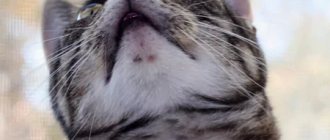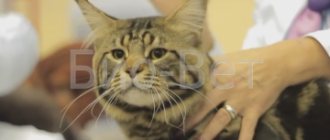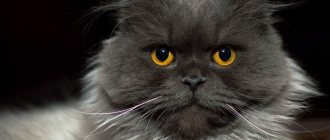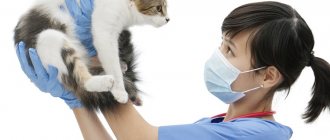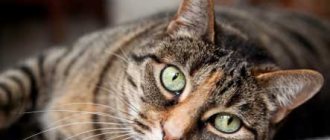Acne can appear on the skin of a cat, just like a person; it is a dermatological disease that is not contagious to humans and is associated with improper functioning of the sebaceous glands. Acne in cats It is quite rare, so acne noticed by the owner on the pet’s chin, on the stomach, near the mouth, ears and base of the tail can cause quite a surprise. It is in these areas of the skin that the sebaceous glands are most numerous - a disruption of the metabolic process in the skin makes their functioning abnormal.
The pores of a cat's skin become clogged due to the accumulation of old epithelium stuck to the young skin cells by sebaceous secretions. Cat pimples can be white or black depending on whether the sebaceous plug is inside or outside the pore.
Since the process does not always develop into pathology, the phenomenon of self-healing takes place. But when pathogenic microbes get into the pores, the pet’s health faces problems: even the behavior of the animal shows how uncomfortable it is. The sore spot itches and hurts, the cat doesn’t feel well, so treatment begins immediately.
Causes of acne in cats
Since acne can affect any pet, it is worth carefully studying the list of causes that provoke the disease:
- constant stress causes active work of the sebaceous glands;
- if a cat gets his chin dirty, you should understand that he will not wash it himself, and the dirt with microorganisms will remain on the skin;
- skin diseases;
- malfunction of the sebaceous glands;
- poor development of hair follicles (alopecia);
- weak immunity;
- plastic dishes, especially those that are not the first freshness, are a breeding ground for bacteria that have accumulated in their micropores.
Rashes on the skin can appear in both a kitten and an elderly cat, and despite this, sphinxes suffer from acne more often, and neutered cats and sterilized female cats suffer from acne in isolated cases.
Characteristics of acne
Acne is a condition caused by excessive sebum production. Such a malfunction occurs when the sebaceous glands are disrupted, and the result is blackheads, blackheads and pimples.
Very often, skin problems occur in areas that the animal is not able to clean thoroughly naturally, such as the chin, belly, or near the ears.
With proper treatment, it does not pose a threat, being mostly a cosmetic problem.
However, if the disease is neglected, it can develop into dermatitis , which will require more serious treatment. In addition, there is a risk of secondary infection if the cat scratches the affected areas.
Some owners may be concerned about the question: is this condition contagious to humans? No, cat acne is not transmitted to humans or other animals, since its occurrence is caused by a malfunction of the sebaceous glands without the participation of bacteria or viruses.
Causes
Veterinarians are still debating the causes of this disease. Today, there are several main factors that can provoke the appearance and development of acne:
- Stress. This phenomenon is also characteristic not only of people, but also of animals, as a result of which problems in the functioning of the sebaceous glands may arise.
- Pathologies of the development of the sebaceous glands. This is often an innate characteristic of a particular animal.
- Hormonal imbalances.
- Painful conditions of the cat. In particular, these include reduced immunity, skin diseases, etc.
- Allergic reactions.
Acne can also occur due to improper care: an abundance of fatty foods, infrequent washing of cat bowls, insufficient bathing of the animal.
Often the chin is one of those areas that the cat is not able to thoroughly wash on its own, so the owner’s help is required.
Main symptoms
Acne most often manifests itself with a number of characteristic symptoms that increase as the disease progresses. As a rule, these are the following groups of signs:
- Black dots. The first sign of skin problems that you should pay attention to is that blackheads tend to grow. Large clumps may appear as dirty spots on the fur.
- Skin redness and swelling.
- Pimples. Typically, acne in cats is also accompanied by the appearance of small pimples with white tips. Over time, their number may increase.
- Ulcers, nodules. If measures to treat the disease are not taken in time, skin inflammation will gradually progress to the stage of ulcers and painful nodes.
- Itching. Often the appearance of acne is accompanied by painful itching, forcing the cat to scratch the skin until the wounds become bloody.
- Baldness. If the disease is neglected too much, sooner or later the hair on the affected areas will begin to thin out significantly, which threatens complete baldness.
Reviews from veterinarians about acne
global $ads_google;
//data-ad-slot=”2475549904″ $ads_google = empty($ads_google) ? false : true; ?> if ($ads_google == false) {?> $ads_google = true; ?> } ?> The opinion of representatives of veterinary dermatology is expressed in the advice not to self-medicate, but to visit a specialist: the sick animal must be examined, a scraping taken from the affected area of the skin and a laboratory test performed. This is done in order to exclude the possibility of other diseases, including allergies.
Feline acne is similar in symptoms to dermatophytosis, demodicosis, scabies and eosinophilic granuloma. The analysis will show whether there is reason to worry about the above diseases.
Veterinarians do not consider the disease to be serious and prescribe a qualified treatment regimen, which, if followed, will solve the problem quickly and easily.
Standard diagnostics
Although acne on a cat’s chin may seem like a minor disease that does not require consultation with a veterinarian, this impression is wrong.
You need to seek help at least in order to make a differential diagnosis, which will help determine whether this is really a simple malfunction of the sebaceous glands or something more dangerous.
The appearance of red pimples on the face can be a symptom of many other diseases: demodicosis, allergies, scabies, eosinophilic granuloma, etc. Some of these conditions pose a threat to humans, so contacting a veterinarian is necessary.
When visiting a veterinary clinic, specialists must take a skin scraping and use it to make an accurate diagnosis. Depending on the test results, appropriate treatment is prescribed.
Treatment of acne in cats
Acne can also appear on the tail, which also brings problems and inconvenience to the pet. At home, it is recommended to follow a diet and follow the instructions of veterinarians, who always tell in detail how to treat acne .
First of all, you should take care of the hygiene of the living conditions of the animal and the mustachioed sufferer himself. In cats, black spots on the chin can turn into large abscesses and seriously complicate life. Maintaining hygiene will not allow the disease to progress to the next stage due to the penetration of microorganisms into the pores.
Treatment is prescribed according to the following scheme:
- the affected areas are regularly washed with medicated shampoos;
- before applying medications, the skin is first disinfected with hydrogen peroxide 3%;
- if the pet is fluffy, then it is better to shave the hair on the affected area;
- Be sure to exclude fatty foods from the diet.
If the case is complex, and a secondary source of infection has joined, then a topical antibiotic and a course of vitamin A are included in the regimen.
Folk remedies for treating acne in cats
Not everyone wants to use ready-made products and turn to folk recipes for treating acne in cats .
- Calendula tincture is used as a treatment;
- two tablets of furatsilin are ground into powder and mixed with three tablespoons of chamomile decoction. The resulting solution is stored in the refrigerator and used to treat ulcers 5-6 times a day;
- squeeze the juice out of the pumpkin and wipe the affected area 4 times a day for 5 minutes;
- An effective decoction is obtained from celandine, which is prepared from four tablespoons of dry raw materials and a liter of water. The broth is brought to a boil, removed, cooled and filtered. Apply lotions to the wounds 3 times a day.
However, before you start treating kitty with folk remedies, consult a veterinarian.
Causes and provoking factors
The cause of the problem may be the individual characteristics of the body. At the same time, the owner needs to properly care for the pet, which will reduce the number of black spots. An additional factor in the occurrence of acne in the chin area is that this area has the least amount of hair. This makes it easier for bacteria to get into the pores.
Additional factors:
- poor nutrition;
- hormonal disorders;
- decreased immunity;
- liver diseases;
- pathologies of the sebaceous glands.
When the sebaceous gland is blocked, the excretory duct may become inflamed, which causes pain.
The problem can also occur on the hips, elbows and eyelids. Inflamed sebaceous glands can cause discomfort to the animal, causing pain. The skin in the acne area becomes red and sometimes swells slightly. Chronic intoxication, which occurs as a result of infection of the body with parasites, can provoke the appearance of black spots. At the same time, the waste products of helminths contribute to disruption of the functioning of various systems.
Attention! If a cat has acne, it is necessary to check the condition of the paraanal glands, which are located next to the anus. If they are inflamed, you should definitely consult a doctor. Otherwise, acne will appear again and again.
Why acne occurs in animals - video
Cat acne on the chin
Black dots may suddenly appear on the cat's face in the lip area. The muzzle seems dry. Gradually the rashes turn into pustules. They will soon burst, and in their place a scab will become noticeable. The next symptom is hair loss with the formation of dry, inflamed skin in this area.
The cat often scratches its chin, thereby causing a secondary infection and injuring the sore spot.
Pus may begin to leak from the pimples, which means that the process has gone far, and the suffering cat urgently needs help.
Someone is lucky, and his pet never encounters the problem of acne breakouts in his life, but visits some kind of pussy with enviable regularity. You should always carefully examine the animal's face so that if a rash appears, treatment can begin immediately.
Treatment of acne in cats on the chin
global $ads_google;
//data-ad-slot=”2475549904″ $ads_google = empty($ads_google) ? false : true; ?> if ($ads_google == false) {?> $ads_google = true; ?> } ?> Judging by the reviews of cat owners who have suffered from this dermatological disease, complex treatment will very soon give a good result.
How veterinarians advise treating acne:
- the chin is treated several times a day: the shaved area is washed with tar soap, antiseborrheic shampoo or Lactaderm. The shampoo is left on the cat’s skin for 4-5 minutes, washed off with a damp cotton swab and wiped until dry;
- Chlorhexidine or hydrogen peroxide are used as antiseptics. After 15 minutes, proceed to the next stage of treatment;
- the cat is laid on its back and a soft cotton piece of cloth soaked in moderately hot decoction of calendula is applied to the sore spot;
- the lesion is wiped with salicylic acid and acne ointment for animals is applied.
A diet with a vitamin course and all stages of treatment are carried out until all spots and ulcers completely disappear.
Disease prevention
Every effort can be made to reduce the likelihood of acne in cats. To do this you need to adhere to certain rules. Do not try to give your pet very greasy or fatty foods. Human food can harm your pet and contribute to various diseases.
You should always wash dishes from which your cat drinks or eats. Replace plastic bowls with metal or glass ones. This will prevent bacteria from multiplying. Monitors the cat's fur and well-being, and keeps the house clean. It is advisable to visit a veterinarian once every six months to make sure your cat is healthy.
Treatments for cat acne
The list of medicinal drugs includes Chlorhexidine, Miramistin, hydrogen peroxide, salicylic alcohol and iodine. These are antiseptic and disinfectants. There are also narrowly targeted drugs:
- Percutan - the medicine contains furatsilin, and if it is used twice a day according to the instructions, the coat color will turn yellow, but this is temporary;
- Bactroban - an ointment for external use is used at the stage of purulent and bloody crusts, as well as when a secondary infection occurs;
- Mupirocin is an effective ointment for external use;
- Differin, Adaklin, Clenzit are vitamin A in the form of ointments, but you should not apply them diligently due to possible skin irritation;
- Prednisolone - a course of treatment is prescribed only by a doctor in particularly advanced cases.
Do not forget that all medications are used only with the permission of a doctor.
How to distinguish acne from other pathologies
It is important to be able to distinguish black dots from waste products of blood-sucking parasites and their larvae, as well as from droplets of dried blood that could appear as a result of trauma to the skin. Differentiating one condition from another is quite simple. You need to carefully try to detach the black lump. If it comes off easily from the skin and is dark brown in color, then it is dried blood.
Dried blood on a cat's chin looks like inflammation of the sebaceous glands
It is important to inspect the surface for scratches and small wounds. If the black dot has separated from the skin, but has a dense consistency and is difficult to press, then most likely these are waste products of ticks or fleas. Less commonly, these can be larvae of blood-sucking parasites. Acne is indicated by the inability to separate the blackhead from the skin. At the same time, it is as if soldered into the mouth of the sebaceous gland.
Flea larvae in cats can be confused with blackheads
If, in addition to acne, the animal has other symptoms, such as lethargy, appetite disturbances, diarrhea, then you should definitely consult a doctor.
Preventing acne in cats
For prevention purposes, plastic utensils are replaced with glass, ceramic or iron. The bowl is washed 1-2 times a day, and new food is poured only into an empty, clean plate. Water should always be clean and fresh.
If your cat has acne again , then fatty and dry foods are excluded from the food, as this is a risk of relapse of the disease.
For a cat prone to comedones, wipe his face after eating.
Your pet’s immunity needs to be strengthened, so if you have questions, you need to study the recommendations for proper nutrition for your cat.
Does acne occur in small kittens and how to treat it?
Unfortunately, young kittens also get acne. But prevention, treatment and symptoms are identical to those of an adult cat. The main thing is to always monitor the kitten’s appearance and promptly identify the signals it gives you. And wipe your pet’s chin after each meal with a disinfectant wipe or cotton pad with chlorhexedine.
Read more about how to care for a small kitten: How to feed a kitten with a syringe: methods, portions, food, regimen
Thus, acne can appear in a cat at any age. To prevent this from happening, you need to monitor your pet’s hygiene and provide him with a balanced diet. If you still notice black spots on your cat, be sure to show him to the veterinarian, and then strictly follow all the specialist’s instructions.
Clinical features
Usually acne appears asymptomatically, so it is not possible to notice it right away. If the cat is not eating well, suffers from allergies or chronic diseases, the rashes will soon become more numerous. Progression of the pathology is possible with weakened immunity.
Clinical signs of acne:
- the appearance of white or black spots on the chin or near the lips;
- in advanced cases, hair begins to fall out in the affected area;
- later skin itching is noted, the cat is constantly itching;
- sometimes local suppuration occurs.
If left untreated, complications may occur, so you should contact your veterinarian right away. An urgent, detailed examination is required, which is carried out by a doctor in a clinical setting.
We will help you cure your pet. Call 33-94-45!
List and description of possible causes
It’s rare that owners bring their cat to the veterinarian complaining that it has black specks in its fur. Usually they complain of severe itching and non-healing wounds after severe scratching. If these and other symptoms are present, the following diseases should be excluded:
- Demodecosis. Contrary to the erroneous opinion of some veterinarians, this disease still affects cats, although much less frequently than dogs. Demodex (Demodex cati) is considered a habitual inhabitant of the skin and normally does not cause any pathological manifestations. His activity is always provoked by something. Usually these are recent diseases of the internal organs, the postoperative period, prolonged use of antibiotics or severe hormonal fluctuations. All this manifests itself in the appearance of black grains in the cat’s fur, which are not accompanied by itching. It is important! But demodicosis causes the appearance of large bald spots (in severe cases, even partial baldness), in place of which small black dots appear. There is also the concept of juvenile demodicosis, which occurs in kittens aged 2-6 months. It usually affects the chin and flexor limbs. In most cases, it goes away on its own without the use of any medications. It is noted that demodicosis occurs more often in decorative breeds (Scots, British, Sphynx, Siamese).
- Flea dermatitis. Another reason why a cat may have black spots under its fur. A distinctive feature is that the parasites themselves may not be on the animal, since one bite is enough to provoke an allergic reaction to the flea’s saliva. The pet begins to behave restlessly, scratching its ears or chin (most often).
- Food allergies. A common phenomenon among decorative breeds. The slightest disturbance in the diet can provoke a severe allergic reaction, which manifests itself in the appearance of black grains in the fur, flaking, redness and hair loss (in some cases in clumps). The allergen is determined by exclusion, but most often the owners have to solve the problem for life with the help of drugs against itching and inflammation.
- Fleas. A real nightmare for cats of all ages. Even if you don't see them on your pet, it doesn't mean that fleas aren't biting him. You can get infected from other animals (dogs) or through objects brought from the street (even the soles of your shoes can have parasites). There are many cases when fleas were brought home along with the grass that cats love to eat in the spring and summer. At first, you may notice that your pet begins to itch more than usual (most attention is paid to the face). Over time, you may notice the appearance of black grains of sand under the fur, which fall off the animal after each stroking or combing. Large bald patches begin to appear due to scratching. In these places, brown-black crusts form on the skin due to claw wounds. The most correct solution would be to immediately treat all animals that have access to each other with anti-parasite drugs. Drops on the withers of Stronghold and Frontline are excellent against fleas and ticks. Process 2 times a month. Much attention is paid to the disinfection of housing, which is carried out using Parastop.
- Bacterial damage. A common occurrence in animals predisposed to allergies. Constant itching leads to deep calculations through which infection enters. Wounds can fester and take a long time to heal. Using cytology, the pathogen is determined and effective anti-inflammatory drugs are selected. In severe cases, antibiotic therapy is used.
- Dermatophytosis. A fungal infection that affects the cat's fur and skin. Small black grains and redness can be found at the site of the lesion. As the process progresses, the affected area transforms into a weeping wound the size of an egg. Severe itching leads to deep scratching and the process spreading to other parts of the body. Most often, pets who have free access to the street and, accordingly, to stray animals suffer. To confirm the diagnosis, a deep pluck is taken from the lesion for microscopic examination. This area can also be illuminated under a Wood's lamp, which will show a bright green glow if there are fungal spores in the fur. Treatment is long, with the use of antifungal drugs in the form of tablets, ointments and shampoos. To avoid relapse, all places with which the infected animal comes into contact are thoroughly washed with water and bleach and chlorhexidine.
Methods for eliminating comedones in pets
You can eliminate blackheads in a cat using an integrated approach to the problem. To do this, you should normalize the pet’s diet, eliminating everything harmful to its body, and also carry out deworming, that is, get rid of worms using one of the specialized drugs: Milbemax, Drontal, Dirofen, etc. You can also use topical pharmaceuticals for treatment. applications. Traditional methods will help complement therapy and make it more effective.
To eliminate acne, first of all, it is necessary to deworm your pet using the drug Milbemax or other similar products.
You should start eliminating comedones only after consulting a doctor, since the cause of the pathology can be serious disturbances in the functioning of the body.
Pharmacy and folk remedies
To eliminate acne in adult animals, the drug Percutan can be used. This medication has antibacterial properties, due to which it prevents the proliferation of pathogenic microflora and eliminates the inflammatory process. The medicine is available in the form of a solution for external use. It should be applied with a cotton swab 2 times a day to the affected areas of the skin. The course of treatment should be from 4 to 10 days.
Percutan has an antibacterial effect
Also, the area affected by blackheads can be treated with calendula tincture, which has anti-inflammatory and antiseptic properties. This product can regulate the functioning of the sebaceous glands, reducing fat production. The tincture should be used once a day. The most convenient way to apply the liquid is with a cotton swab. The treatment course should not exceed 4–5 days, since the tincture contains alcohol, which can dry out the skin.
Calendula tincture eliminates inflammation
For treatment, you can also use Furacilin solution, which is active against a wide range of microorganisms. At the same time, bacteria and inflammation are eliminated, due to which comedones gradually disappear. 1 tablet of Furacilin must be dissolved in 1 glass of warm water. Treat the affected area with the resulting liquid 3 times a day for a week.
Furacilin produces an antiseptic effect
It is also possible to use retinol (vitamin A) in the form of ointments and creams. These products include: Differin, Clenzit and others. These drugs should be used with caution, as they can cause severe skin irritation. Apply the ointment with a cotton swab in a thin layer every other day for a week. If your pet experiences itching and redness of the skin, then it is recommended to abandon this method of treatment.
Clensite helps eliminate acne, but can cause irritation
Another effective remedy for eliminating the problem is a solution of methylene blue, which can be purchased at a pharmacy. It soothes the skin by eliminating overactive sebaceous glands. You can treat the affected areas with this product no more than once a day for 3-4 days. If during this time the blackheads have not disappeared, then it is recommended to use another method, since methylene blue slightly dries out the skin.
Methylene blue relieves acne and heals skin
To get rid of comedones, you can also use Chlorhexidine. It eliminates bacteria and excess sebum, while blackheads decrease in size and then completely disappear. The solution should be used no longer than 4–5 days, because it can dry out the epidermis. Wipe the skin with this product 2 times a day using a cotton pad. It is advisable to do this after the pet has eaten.
Chlorhexidine should not be used for more than 5 days
For treatment, you can also use Elite shampoo, which is designed specifically for the treatment and prevention of skin diseases in cats and dogs. This product contains chlorhexidine, plantain and celandine extract, glycerin and provitamin B with allantoin. The shampoo is easily applied to the coat, foams and is washed off with warm water. After just a few uses, acne will disappear.
Elite shampoo is designed specifically for the treatment of skin diseases
In advanced cases, when a secondary infection occurs and suppuration occurs, it is recommended to use tetracycline ointment, which is active against a wide range of pathogenic microorganisms. This remedy should be applied to the site of inflammation 2 times a day. The course of treatment varies from 7 to 10 days. If at the end of therapy there is no result, then you should definitely consult a doctor.
Tetracycline ointment is active against a wide range of bacteria
An excellent folk remedy that helps solve this problem is tar soap. You can use it without fear. This remedy rarely causes allergic reactions, but it eliminates inflammation, fungal and bacterial infections, and also promotes tissue regeneration. Tar soap should be applied to the affected area once a day for a week. In this case, the skin should be pre-moistened with water. After application, you need to wait 5 minutes and then rinse off the product.
Tar soap does not cause allergic reactions
A good effect is produced by chamomile infusion, which eliminates inflammation and skin itching. You will need 1 tbsp. l. dry raw materials, which needs to be poured with a glass of boiling water and left for 1 hour. Then filter the liquid and apply it to the acne area 4 times a day using a cotton pad. The course of treatment is from 10 to 14 days.
Chamomile infusion helps you get rid of blackheads faster
Attention! Under no circumstances should you squeeze your pet's acne. Otherwise, you can provoke increased inflammation and the addition of infection, which will lead to the occurrence of furunculosis.
A friend has a white cat that has black spots on its chin. No one would have thought that animals could also have such a problem. A friend was scared at first because she thought it was not acne, but some kind of serious disease, so she immediately took her pet to the doctor. After examination, the vet said that these were just black dots. Prescribed Chlorhexidine and medicated shampoo. We managed to get rid of the problem in less than a week. Additionally, the doctor recommended paying attention to your pet’s diet.
How to rid a cat of acne - video
Diet food
In order to speed up your pet's recovery, it is recommended to normalize its diet. It is necessary to exclude everything fatty and fried from the cat’s menu, as well as milk and sour cream. It is best to feed your pet a specialized product suitable for a specific breed. In this case, preference should be given not only to dry options, but also to include in the animal’s menu boiled chicken and fish, carrots (which can be mixed with the main food), eggs, cottage cheese, as well as grass, which can be purchased at a veterinary store.
Boiled chicken should be included in your cat's menu
To prevent the problem from occurring regularly, it is important to avoid cheap food that contains a large amount of flavorings, preservatives, and salt, which increases the risk of urolithiasis. This product is very harmful to the pet's immune system. It is recommended to purchase food from the Royal Canin, Purina and other series.
Royal Canin - a line of quality cat food
It is also important that clean boiled water is always available to your pet. At the same time, for watering and feeding, it is better to give preference to iron or glass bowls, since plastic ones emit toxic substances that are harmful to the animal’s body. To strengthen the immune system and to reduce the risk of recurrence of acne, you can include special feed additives containing vitamins (Beaphar and others) in the menu.
It is better to use iron bowls to feed your pet.
To prevent malfunctions in the cat’s body, you should never give your pet bones, raw fish, sweets, as well as onions and garlic.
Can a kitten develop blackheads?
Comedones in kittens occur in isolated cases, since the body of most pets works smoothly up to 6 months. However, if such a problem does arise, then only non-aggressive means can be used for treatment. When eliminating black spots in kittens, you can use chamomile infusion, tar soap, and Furacilin. These products should be used once a day. The exception is chamomile infusion. It can be used 3-4 times a day. The course of treatment is often from 5 to 7 days.
Acne in kittens occurs in isolated cases
The occurrence of acne in kittens should be alarming, as this may be a sign of gastrointestinal dysfunction. It is important to monitor your pet's stool and appetite. If there are no alarming symptoms, then only local remedies can be used for treatment.
Treatment
Treatment depends on how advanced the process is; in the early stages, you can try to solve the problem yourself; if there are a lot of pimples or blackheads, a secondary infection has occurred, the animal is actively itching and injuring itself, you need to consult a veterinarian.
But in any case, treatment involves:
- getting rid of existing pimples and blackheads;
- eliminating the cause of their occurrence;
- prevention of new ones;
- eliminating inflammation and preventing the spread of rashes.
You need to start treating pimples and acne as soon as they appear. Squeezing pimples is strictly not recommended. The affected areas are treated with anti-dandruff shampoo to remove excess sebum and reduce its secretion. Then the pimples are thoroughly treated with a solution of local antiseptics (Chlorhexidine). You can fight acne with Percutan. But this product can stain the fur, so it should not be used if the animal is participating in exhibitions. In this case, you need to familiarize yourself with the rules of feeding the animal and harmonize its diet.
If this treatment does not help, you need to contact a veterinarian to clarify the diagnosis and more intensive treatment, using anti-inflammatory drugs, antibiotics and hormones.
Treatment with home remedies
In the mild, initial stages of the disease, the problem can be dealt with using home and folk remedies. Do not forget that acne treatment must be agreed upon with a veterinarian.
Sometimes treating blackheads with a two-phase makeup remover helps. By carefully blotting with a cotton swab moistened with the product, excess sebum and dirt are removed from the affected areas, and the skin is disinfected.
It is important to remember that this method can only be used in the absence of ulcers and inflammation.
If the nature of the disease is allergic, then changing the food or replacing plastic dishes with metal and earthenware usually helps.
If there are no ulcers, inflammations, or infected wounds, the use of folk remedies is acceptable. For example, lubricate acne with a mixture of two Furacilin tablets and chamomile decoction or fresh pumpkin juice. If there are a small number of blackheads and no pustules, lotions made from celandine infusion or yarrow decoction can also help.
Symptoms
After detecting acne, it is recommended to examine your pet for other abnormalities:
- bald spots - bald areas;
- swelling of the body, edema;
- hyperemia of the skin;
- pimples, the number of which increases over time.
Changed behavior is also a warning sign. If the animal is constantly itching, then black spots in the cat's fur are accompanied by itching on the neck.


